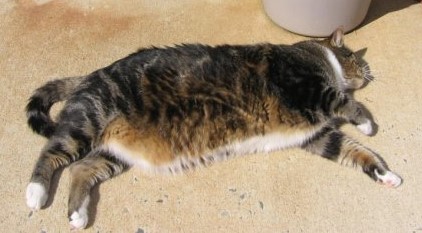Pet obesity is an extremely common issue in veterinary medicine. Statistics from 2018 showed that 60% of cats and 56% of dogs were considered overweight or obese in the United States. Commonly, pet owners are not even aware that their pet is overweight. Obesity in your pet can predispose them to significant health issues and pain, just like in humans. Here are a few commonly asked questions from pet owners and insider tips to help ensure your pet is healthy and in their ideal weight range.
Why is it bad if my pet is overweight?
Just like in humans, extra weight can put more pressure on your pet’s heart, internal organs and joints. Being overweight can increase your pet’s risk of arthritis, joint or ligament disease, diabetes, and heart disease. These diseases can be expensive and difficult to treat and can greatly affect your pet’s life span and quality of life. By ensuring your pet remains at a healthy weight, you can help them live a longer and happier life with you.
How can I tell if my pet is overweight?
The best way to assess your pet’s ideal weight is to consult your veterinarian. A healthy pet should have a defined waist and tucked belly. You should be able to feel your pet’s ribs without having to press in to feel them, but you should not be able to see them. If your pet’s bones are very prominent, they may be underweight, whereas if you are unable to identify their waist or ribs, they may be overweight. Typically, pets are scored on body condition on a 1-5 scale or a 1-9 scale. ? and 4-5/9 are ideal scores for your pet’s weight.
Measure your pet’s food
Do you measure the amount of food you feed your pet? Does your pet have a designated meal time or are they allowed to graze or free feed throughout the day? Measuring your pet’s food and keeping them on a regular feeding schedule can be an essential step in ensuring they stay at a healthy weight. By measuring their food and monitoring the amount they consume, not only can it help with weight loss, it can also help you to identify if your pet is eating more or less than usual, which can be a sign of possible health changes. The amount of food that you should feed your pet depends on a variety of factors – one size does not fit all.
Check the bag
Depending on the type of food you feed your pet, the number of calories in each type of food varies. For richer diets or smaller pets, your pet may need only a small amount to satisfy their caloric needs. We recommend using a measuring cup instead of a scoop or solo cup to measure your pet’s food to ensure accuracy. Not all cups are the same size. If you are not sure how much you should be feeding your pet – check your pet’s food bag to see what is recommended for their weight. Note, it is recommended to feed your pet for their ideal weight, not their current weight if they are overweight. If you have any questions about what your pet’s ideal weight or ideal diet recommendation should be, we recommend contacting your veterinarian.
Choose healthy treats
One of the biggest causes of obesity in pets is overfeeding. This most commonly is correlated with pets getting too many treats or indulging in human food. Treats should make up less than 10% of your pets diet. A single milk bone can have up to 100 calories. For small dogs, this can constitute enough calories for almost an entire meal! Use treats wisely. For training, using pieces of your pets kibble or breaking treats into multiple small pieces can help prevent splurging.
Feeding your pet off of your plate can lead to behavioral issues such as begging and counter swiping. In addition to these annoying habits, feeding your pet foods other than their regular dog food can lead to health issues such as gastroenteritis and pancreatitis in addition to obesity. Certain human foods can even be toxic to pets. Some acceptable human foods for your pet that are healthier alternatives are unsalted green beans and baby carrots. For any specific diet related questions, please do not hesitate to contact your veterinarian to discuss.
Ensure adequate exercise
To keep your pet healthy, regular periods of exercise is recommended. Walking, playing with toys, throwing the ball, running, learning new tricks, and other enrichment activities can be useful for your pet’s mental and physical stimulation. If your pet is a couch potato, has medical issues that prevent regular exercise, or the weather is not conducive to exercise, options such as placing their food in kong toys or interactive feeders can help make them work for their food.
If your pet is significantly overweight or obese, your veterinarian may recommend a prescription weight loss diet that is high in fiber and low in fat. These diets can be beneficial to promote regular, consistent weight loss. If you think this type of diet may be a good fit for your pet, please contact your veterinarian.
For any specific questions relating to your pet, their weight or their diet, please call your veterinarian or contact us at 704-847-8466.

